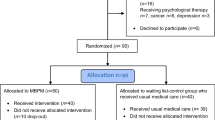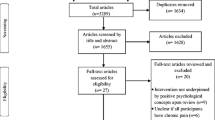Abstract
Purpose
This study aims to examine if mindfulness is associated with pain catastrophizing, depression, disability, and health-related quality of life (HRQOL) in cancer survivors with chronic neuropathic pain (CNP).
Method
We conducted a cross-sectional survey with cancer survivors experiencing CNP. Participants (n = 76) were men (24 %) and women (76 %) with an average age of 56.5 years (SD = 9.4). Participants were at least 1 year post-treatment, with no evidence of cancer, and with symptoms of neuropathic pain for more than three months. Participants completed the Five Facets Mindfulness Questionnaire (FFMQ), along with measures of pain intensity, pain catastrophizing, pain interference, depression, and HRQOL.
Results
Mindfulness was negatively correlated with pain intensity, pain catastrophizing, pain interference, and depression, and it was positively correlated with mental health-related HRQOL. Regression analyses demonstrated that mindfulness was a negative predictor of pain intensity and depression and a positive predictor of mental HRQOL after controlling for pain catastrophizing, age, and gender. The two mindfulness facets that were most consistently associated with better outcomes were non-judging and acting with awareness. Mindfulness significantly moderated the relationships between pain intensity and pain catastrophizing and between pain intensity and pain interference.
Conclusion
It appears that mindfulness mitigates the impact of pain experiences in cancer survivors experiencing CNP post-treatment.
Implications for cancer survivors
This study suggests that mindfulness is associated with better adjustment to CNP. This provides the foundation to explore whether mindfulness-based interventions improve quality of life among cancer survivors living with CNP.


Similar content being viewed by others
References
Ganz PA, Desmond KA, Leedham B, Rowland JH, Meyerowitz E, Belin TR (2002) Quality of life in long-term, disease-free survivors of breast cancer: a follow-up study. J Natl Cancer Inst 94:39–49
Task Force on Taxonomy of the International Association for the Study of Pain (1994) Classification of chronic pain. Descriptions of chronic pain syndromes and definitions of pain terms. IASP Press, Seattle
Treede RD, Jensen TS, Campbell JN, Cruccu G, Dostrovsky JO, Griffin JW, Hansson P, Hughes R, Nurmikko T, Serra J (2008) Neuropathic pain: redefinition and a grading system for clinical and research purposes. Neurology 70:1630–1635
Jung BF, Ahrendt GM, Oaklander AL, Dworking RH (2003) Neuropathic pain following breast cancer surgery: proposed classification. Pain 104:1–13
Kanner R (2001) Diagnosis and management of neuropathic pain in patients with cancer. Cancer Invest 19:324–333
Gulluoglu BM, Cingi A, Cakir T, Gercek A, Barlas A, Eti Z (2006) Factors related to post-treatment chronic pain in breast cancer survivors: the interference of pain with life functions. Int J Fertil Womens Med 51:75–82
Vlaeyen J, Linton S (2000) Fear-avoidance and its consequences in chronic musculoskeletal pain: a state of the art. Pain 85:317–332
Wong WS, Lam HMJ, Chow YF, Chen PP, Lim HS, Wong S, Fielding R (2014) The effects of anxiety sensitivity, pain hypervigilance, and pain catastrophizing on quality of life outcomes of patients with chronic pain: a preliminary, cross-sectional analysis. Qual life Res 2333–2341
Veehof MM, Oskam MJ, Schreurs KMG, Bohlmeijer ET (2011) Acceptance-based interventions for the treatment of chronic pain: a systematic review and meta-analysis. Pain 152:533–542
Carlson LE, Ursuliak Z, Goodey E, Angen M, Speca M (2001) The effects of a mindfulness meditation-based stress reduction program on mood and symptoms of stress in cancer outpatients: 6-month follow-up. Support Care Cancer 9:112–123
Bishop SR, Lau M, Shapiro S, Carlson L, Anderson ND, Carmody J, Segal ZV, Abbey S, Speca M, Velting D, Devins G (2004) Mindfulness: a proposed operational definition. Clin Psychol Sci Pract 11:230–241
Baer R, Smith GT, Hopkins J, Krietemeyer J, Toney L (2006) Using self-report assessment methods to explore facets of mindfulness. Assessment 13:27–45
Schütze R, Rees C, Preece M, Schütze M (2010) Low mindfulness predicts pain catastrophizing in a fear-avoidance model of chronic pain. Pain 148:120–127
Sullivan MJL, Lynch ME, Clark AJ (2005) Dimensions of catastrophic thinking associated with pain experience and disability in patients with neuropathic pain conditions. Pain 113:310–315
Dillman D (2000) Mail and internet surveys: the tailored design method, 2nd edn. Wiley, New York
Bohlmeijer E, Ten Klooster P, Fledderus M, Veehof M, Baer R (2011) Psychometric properties of the five facets mindfulness questionnaire in depressed adults and development of a short form. Assessment 18:308–320
Bouhassira D, Attal N, Fermanian J, Alchaar H, Gautron M, Masquelier E, Rostaing S, Lanteri-Minet M, Collin E, Grisart J, Boureau F (2004) Development and validation of the neuropathic pain symptom inventory. Pain 108:248–257
Tan G, Jensen MP, Thornby JI, Shanti BF (2004) Validation of the brief pain inventory for chronic nonmalignant pain. J Pain 5:133–137
Kerns D, Turk DC, Rudy TE (1985) The West Haven-Yale Multidimensional Inventory (WHYMPI). Pain 23:345–356
Kerns RD, Haythornthwaite JA (1988) Depression among chronic pain patients: cognitive-behavioral analysis and effect on rehabilitation outcome. J Consult Clin Psychol 56:870–876
Turk DC, Sist TC, Okifuji A, Miner MF, Florio G, Harrison P, Massey J, Lema ML, Zevon MA (1998) Adaptation to metastatic cancer pain, regional/local cancer pain and non-cancer pain: role of psychological and behavioral factors. Pain 74:247–256
Sullivan MJL, Bishop SR, Pivik J (1995) The pain catastrophizing scale: development and validation. Psychol Assess 7:524–532
Sullivan MJL, Martel MO, Tripp D, Savard A, Crombez G (2006) The relation between catastrophizing and the communication of pain experience. Pain 122:282–288
Spitzer RL, Kroenke K, Williams JBW (1999) Validation and utility of a self-report version of PRIME-MD. JAMA J Am Med Assoc 282:1737–1744
Kroenke K, Spitzer RL, Williams JBW (2001) The PHQ-9: validity of a brief depression severity measure. J Gen Intern Med 16:606–613
American Psychiatric Association (2000) Diagnostic and statistical manual of mental disorders, 4th ed. Washington, DC
Rosemann T, Backenstrass M, Joest K, Rosemann A, Szecsenyi J, Laux G (2007) Predictors of depression in a sample of 1,021 primary care patients with osteoarthritis. Arthritis Care Res 57:415–422
Löwe B, Kroenke K, Herzog W, Gräfe K (2004) Measuring depression outcome with a brief self-report instrument: sensitivity to change of the Patient Health Questionnaire (PHQ-9). J Affect Disord 81:61–66
Lee PW, Schulberg HC, Raue PJ, Kroenke K (2007) Concordance between the PHQ-9 and the HSCL-20 in depressed primary care patients. J Affect Disord 99:139–145
Ware JE, Kosinski M, Keller SD (1996) A 12-item short-form health survey: construction of scales and preliminary tests of reliability and validity. Med Care 34:220–233
Ware JE, Kosinski M, Keller SD (1994) SF-36 physical and mental health summary scales: a user’s manual. The Health Institute, New England Medical Centre, Boston
Gálvez R, Marsal C, Vidal J, Ruiz M, Rejas J (2007) Cross-sectional evaluation of patient functioning and health-related quality of life in patients with neuropathic pain under standard care conditions. Eur J Pain 11:244–255
IBM Corp. Released (2011) IBM SPSS Statistics for Windows, Version 20.0. Armonk, NY: IBM Corp
Tabachnick BG, Fidell LS (2001) Using multivariate statistics. Allyn and Bacon, Boston
Frazier PA, Tix AP, Barron KE (2004) Testing moderator and mediator effects in counseling psychology research. J Couns Psychol J Couns Psychol 51:115–134
Paul NA, Stanton SJ, Greeson JM, Smoski MJ, Wang L (2013) Psychological and neural mechanisms of trait mindfulness in reducing depression vulnerability. Soc Cogn Affect Neurosci 8:56–64
McCracken LM, Gutiérrez-Martínez O, Smyth C (2012) “Decentering” reflects psychological flexibility in people with chronic pain and correlates with their quality of functioning. Heal Psychol 32:820–823
Bränström R, Duncan LG, Moskowitz JT (2011) The association between dispositional mindfulness, psychological well-being, and perceived health in a Swedsih population-based sample. Br J Health Psychol 16:300–316
Cook A, Meyer E, Evans L, Morissette S (2015) Chronic pain acceptance incrementally predicts disability in polytrauma-exposed veterans at baseline and 1-year follow-up. Behav Res Ther 73:25–32
McCracken LM, Vowles KE (2008) A prospective analysis of acceptance of pain and values-based action in patients with chronic pain. Health Psychol 27:215–220
Veehof MM, Ten Klooster PM, Taal E, Westerhof GJ, Bohlmeijer ET (2011) Psychometric properties of the Dutch Five Facet Mindfulness Questionnaire (FFMQ) in patients with fibromyalgia. Clin Rheumatol 30:1045–1054
Wilson KG, Chochinov HM, Allard P, Chary S, Gagnon PR, Macmillan K, De Luca M, O’Shea F, Kuhl D, Fainsinger RL (2009) Prevalence and correlates of pain in the Canadian National Palliative Care Survey. Pain Res Manag 14:365–370
Zernicke KA, Campbell TS, Speca M, McCabe-Ruff K, Flowers S, Carlson LE (2014) A randomized wait-list controlled trial of feasibility and efficacy of an online mindfulness-based cancer recovery program: the eTherapy for cancer applying mindfulness trial. Psychosom Med 76:257–267
Boggero IA, Geiger PJ, Segerstrom SC, Carlson CR (2015) Pain intensity moderates the relationship between age and pain interference in chronic orofacial pain patients. Exp Aging Res 41:463–474
Asch DA, Jedrziewski MK, Christakis NA (1997) Response rates to mail surveys published in medical journals. J Clin Epidemiol 50:1129–1136
Kaplowitz MD, Hadlock TD, Levine R (2004) A comparison of Web and mail survey response rates. Public Opin Q 68:94–101
Acknowledgment
This study was supported by a Catalyst Grant from the Canadian Institutes of Health Research.
Author information
Authors and Affiliations
Corresponding author
Ethics declarations
All authors declare that they have no conflict of interest. All procedures performed in this study were in accordance with the ethical standards of The Ottawa Hospital research institute and with the 1964 Helsinki declaration and its later amendments or comparable ethical standards. Informed consent was obtained from all individual participants included in the study.
Rights and permissions
About this article
Cite this article
Poulin, P.A., Romanow, H.C., Rahbari, N. et al. The relationship between mindfulness, pain intensity, pain catastrophizing, depression, and quality of life among cancer survivors living with chronic neuropathic pain. Support Care Cancer 24, 4167–4175 (2016). https://doi.org/10.1007/s00520-016-3243-x
Received:
Accepted:
Published:
Issue Date:
DOI: https://doi.org/10.1007/s00520-016-3243-x




